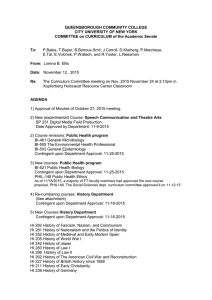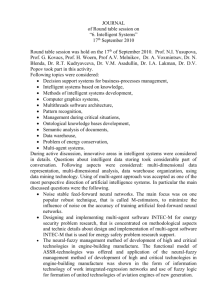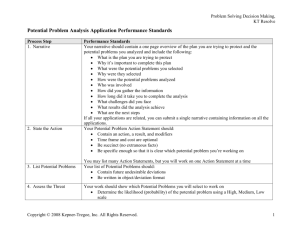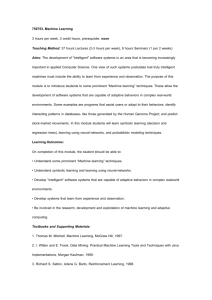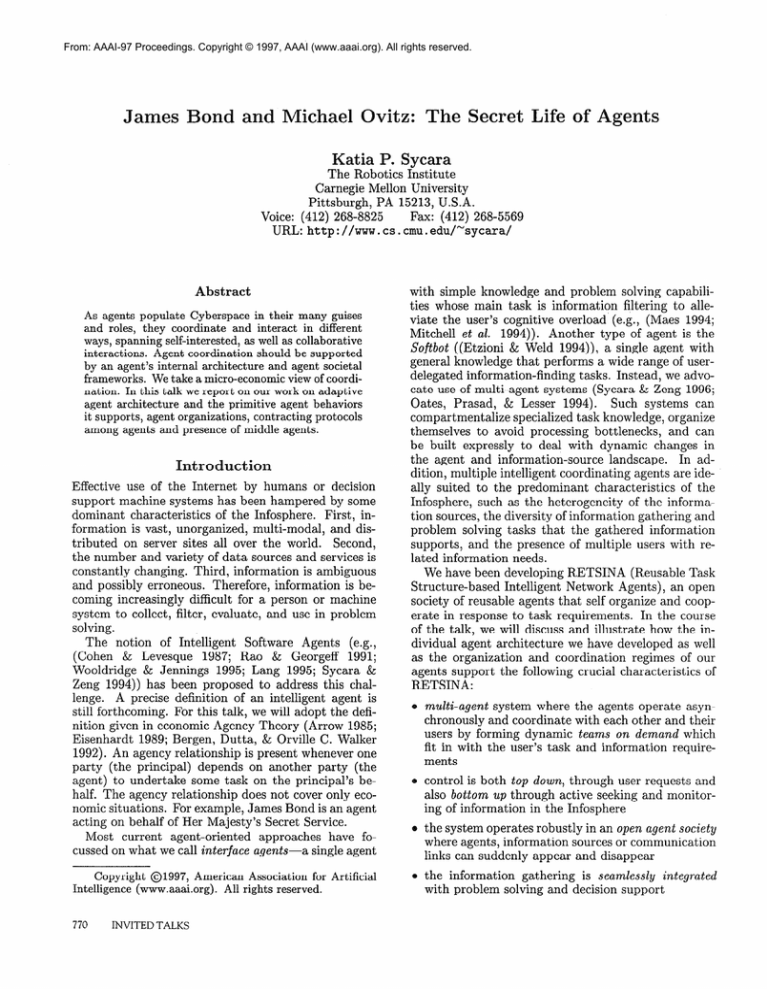
From: AAAI-97 Proceedings. Copyright © 1997, AAAI (www.aaai.org). All rights reserved.
James Bond and Michael Ovitz: The Secret Life of Agents
Katia P. Sycara
The Robotics Institute
Carnegie Mellon University
Pittsburgh, PA 15213, U.S.A.
Fax: (412) 268-5569
Voice: (412) 268-8825
URL:http://www.cs.cmu.edu/“sycara/
Abstract
As agents populate Cyberspace in their many guises
and roles, they coordinate and interact in different
ways, spanning self-interested, as well as collaborative
interactions. Agent coordination should be supported
by an agent’s internal architecture and agent societal
frameworks. We take a micro-economic view of coordination. In this talk we report on our work on adaptive
agent architecture and the primitive agent behaviors
it supports, agent organizations, contracting protocols
among agents and presence of middle agents.
Introduction
Effective use of the Internet by humans or decision
support machine systems has been hampered by some
dominant characteristics of the Infosphere. First, information is vast, unorganized, multi-modal, and distributed on server sites all over the world. Second,
the number and variety of data sources and services is
constantly changing. Third, information is ambiguous
and possibly erroneous. Therefore, information is becoming increasingly difficult for a person or machine
system to collect, filter, evaluate, and use in problem
solving.
The notion of Intelligent Software Agents (e.g.,
(Cohen & Levesque 1987; Rao & Georgeff 1991;
Wooldridge & Jennings 1995; Lang 1995; Sycara &
Zeng 1994)) has been proposed to address this challenge. A precise definition of an intelligent agent is
still forthcoming. For this talk, we will adopt the definition given in economic Agency Theory (Arrow 1985;
Eisenhardt 1989; Bergen, Dutta, & Orville C. Walker
1992). An agency relationship is present whenever one
party (the principal) depends on another party (the
agent) to undertake some task on the principal’s behalf. The agency relationship does not cover only economic situations. For example, James Bond is an agent
acting on behalf of Her Majesty’s Secret Service.
Most current agent-oriented approaches have focussed on what we call interface agents-a
single agent
Copyright 01997, American Association for Artificial
Intelligence (www.aaai.org). All rights reserved.
770
INVITED TALKS
with simple knowledge and problem solving capabilities whose main task is information filtering to alleviate the user’s cognitive overload (e.g., (Maes 1994;
Mitchell et al. 1994)). Another type of agent is the
Sofibot ((Etzioni & Weld 1994)), a single agent with
general knowledge that performs a wide range of userdelegated information-finding tasks. Instead, we advocate use of multi-agent systems (Sycara & Zeng 1996;
Oates, Prasad, & Lesser 1994). Such systems can
compartmentalize specialized task knowledge, organize
themselves to avoid processing bottlenecks, and can
be built expressly to deal with dynamic changes in
the agent and information-source landscape. In addition, multiple intelligent coordinating agents are ideally suited to the predominant characteristics of the
Infosphere, such as the heterogeneity of the information sources, the diversity of information gathering and
problem solving tasks that the gathered information
supports, and the presence of multiple users with related information needs.
We have been developing RETSINA (Reusable Task
Structure-based Intelligent Network Agents), an open
society of reusable agents that self organize and cooperate in response to task requirements. In the course
of the talk, we will discuss and illustrate how the individual agent architecture we have developed as well
as the organization and coordination regimes of our
agents support the following crucial characteristics of
RETSINA:
multi-agent system where
chronously and coordinate
users by forming dynamic
fit in with the user’s task
ments
the agents operate asynwith each other and their
teams on demand which
and information require-
control is both top down, through user requests and
also bottom up through active seeking and monitoring of information in the Infosphere
the system operates robustly in an open agent society
where agents, information sources or communication
links can suddenly appear and disappear
the information gathering is seumlessly integrated
with problem solving and decision support
The structure of an individual agent is based on
the BDI-model (Rao & Georgeff 1991; Decker 1995)
and is compatible with architectures of behavior based
autonomous robotic systems (Simmons 1994). We
present a set of architectural building blocks that support the specification of behaviors for agents in a way
that allows periodic actions, interleaving of planning
and execution, and the concurrent activation of multiple behaviors with asynchronous components. The
planning module takes as input a set of goals and produces a plan that satisfies the goals. The agent planning process is based on a hierarchical task network
(HTN) planning formalism. The communication and
coordination module accepts and interprets messages
from other agents in KQML, or e-mail messages from
human users. The scheduling module schedules each
of the plan steps. Agent reactivity considerations are
handled by the execution monitoring process. Each
agent also has a domain-independent library of plan
fragments (task structures) that are indexed by goals,
as well as domain-specific library of plan fragments
from which plan fragments can be retrieved and incrementally instantiated according to the current input
parameters. The retrieved and instantiated plan fragments are used to form the agent’s instantiated task
tree that is incrementally executed. The belief and
facts data structures contain facts and other knowledge related to the agent’s functionality.
We present an initial set of implemented agent behaviors, including responding to repetitive queries,
monitoring information sources, advertising capabilities, and self cloning. By “behaviors”, we mean the
execution by an agent of partially-ordered sequences
of basic actions. By “reusable”, we mean that the behaviors are specified in terms of domain-independent
abstractions and can be reused in building an agent
for a new domain or task. Currently we have identified and implemented in each RETSINA agent the
following behaviors:
Advertising:
Upon startup, every agent creates an
internal goal to advertise itself. An agent advertises itself by sending a middle agent the information
needed for describing its capabilities and the services
that the advertising agent can provide.
Polling: Message Polling is the simplest
agent behavior. An agent initialization process asserts a goal for the agent to collect and process incoming KQML messages.
Message
Answering
Simple Queries:
A simple query is
one where the agent finds answers to queries and
returns the results to the query-initiator. The query
might be a one-shot question or it might be a request
for periodic monitoring of a particular information
source.
Information
Monitoring:
An information monitoring query is one that is interpreted as expressing
a condition that, when true, will trigger the trans-
mission of the selected information. This condition
is periodically checked with given frequency.
Cloning:
Cloning is one of an agent’s possible
responses to overloaded conditions.
To recognize
whether it is overloaded, the agent uses a simple
model of how its ability to meet new deadlines is related to the characteristics of its current queries and
other tasks. It compares this model to a hypothetical situation that describes the effect of adding a
new agent. If this evaluation suggests that adding a
new agent would be beneficial, the agent removes itself (temporarily) from actively pursuing new queries
(by “unadvertising” its services) and creates a new
agent that is a clone of itself.
The most important reason for our approach is that
behavior specification is the proper level for allowing
people to construct new classes of software agents in a
structured, well-defined way. We are currently working
on an Agent Behavior Editor which will allow more
rapid construction of new classes of agents through the
reuse and combination of existing behaviors, as well as
specification of new behaviors.
In open world environments, agents in the system are
not statically predefined but can dynamically enter and
exit an organization. One of the basic problems facing
designers of open, multi-agent systems for the Internet is the connection problem (Davis & Smith 1983)finding the other agents who might have the information or other capabilities that are needed in support
of a task. There are two special types of information used in this process: preferences and capabilities. In multi-agent information systems, a preference
is (meta) knowledge about what types of information
have utility for a requester. A capability is (meta)
knowledge about what types of requests can be serviced by a provider. In open systems, agents as well
as their capabilities and preferences can dynamically
change.
Agents that deal with preference or capability information and that are neither requesters/principals or
providers/agents (from the standpoint of the transaction under consideration), we call middle-agents. In
human societies, agents such as Michael Ovitz serve as
middle agents facilitating service requesters and service providers to get in touch with each other. Middle agents have not been explicitly modeled in Agency
Theory. We will examine the connection problem from
the standpoint of privacy considerations. Prom a privacy standpoint, preference information can flow from
a requester to a provider, and capability information
can flow the other way. Privacy, however, is only one
concern when choosing a solution to the connection
problem. A designer also needs to consider other characteristics, such as the efficiency with which requests
are handled and resources are used, the vulnerability of
INVITED TALKS
771
the system to the failure of some component, and the
ability to quickly adapt to changing preferences and
capabilities. Our ongoing research aims to develop empirically validated models of the relationships between
the various performance characteristics and system parameters.
Preference information can initially be kept private
at the requester, be revealed to some middle agent,
or be known by the provider itself. The same three
This
possibilities exist for capability information.
leads to nine general middle-agent roles in informationgathering organizations. Here we mention the three
A blackboard
most significant middle agent types.
is a middle-agent that keeps track of requests. Requesters post their problems; providers can then query
the blackboard agent for events they are capable of
handling. This class includes newsgroups and bulletin
boards. A broker is a middle-agent that protects the
privacy of both the requester and provider. The broker
understands both the preferences and capabilities, and
routes both requests and replies appropriately. Neither
the requester nor provider ever knows directly about
the other in a transaction. A matchmaker/yellow-pages
is a middle agent that stores capability advertisements
that can then be queried by requesters. The requesters
then choose and contact any provider they wish directly.
We will discuss the scope of design possibilities presented by our model. We will also present experimental results that show tradeoffs among agent types
using various resource allocation and load balancing
schemes. Our experimental results were achieved using an implementation of the RETSINA framework in
multi-agent financial portfolio management (the WARREN system)(Sycara et al. 1996).
Agency and Contracting
Each agent may handle requests from several other
agents and may be in a position to choose which
requests it will honor in order to use its local resources most effectively. Correspondingly, an agent
chooses to request services from the agent who offers
the most attractive deal. Thus, in the most general
case there is an electronic marketplace consisting of
agents that have their own goals and resources, and
follow their own strategies (e.g. (Kraus 1994), (Sandholm & Lesser 1995)). The design and analysis of interaction protocols for such agents is part of the growing field of automated negotiation systems(Oliver 1996;
Rosenschein & Zlotkin 1994). A major component of
automated negotiation is contracting.
Agency theory uses the metaphor of a contract to describe relationships in which one party delegates work
to another. The focus of the theory is on determining the most efficient contract to govern a particular
relationship given the characteristics of the parties involved, environmental uncertainty and incomplete information.
In general, there are two sets of issues
772
INVITED TALKS
when entering a relationship with an agent. First, precontractural issues, arising before the principal decides
to offer an agent a contract. The major issues here
are whether a particular agent has the capabilities the
principal is seeking and what strategy the principal
can follow in order to find out. In RETSINA, such issues are handled by middle agents. Second, there are
postcontractual issues after the principal and the agent
have engaged in a relationship. Such issues include how
the principal should evaluate and reward the agent’s
performance, and what information strategy could be
used to make such an evaluation. In RETSINA, these
issues are handled through (1) the execution monitoring module and (2) option-based computational algorithm for valuing contingent contracts.
In most existing literature on agency theory, game
theory or multi-agent systems, the contracts considered are binding. A contract is binding for an agent if
the agent cannot get out of its contractual obligations.
When an agent can get out of a contractual obligation, the contract is called non-binding or contingent.
Contingent contracts allow agents increased flexibility
and, in many situations, non-binding contracts are superior to binding ones. Introducing contingent contracts has two main advantages: (1) The space of possible contracts is enhanced, so the expected utility can
be higher, and (2) Contingent contracts can reduce the
variability of an agent’s payoff, since an agent can postpone a decision for the future when more information
could be available.
In game theory, the value of a contract is assumed
known and used as input to the game-theoretic solution
concepts such as Nash equilibrium and its extensions
(e.g., sequential equilibrium, perfect Bayesian equilibrium (Fudenberg & Tirole 1991)). This approach does
not address issues such as contract valuation, contract
flexibility, or the nonstationary nature of the underlying uncertainty. More sophisticated computational
mechanisms are needed.
The approach we will present is based on financiul option pricing theory. We believe that modeling contingent contracts under time-dependent uncertainty and risk as options provides a natural unified
framework for taking into account contracting flexibility and complex forms of environmental uncertainty.
In addition, option pricing provides a computationally
tractable formalism for calculating optimal values of
various contracting decision parameters, that to date
have not been rigorously modeled. Such parameters inelude the value of a flexible/contingent contract, when
to give out a contract to an agent, when to break a
contract, and which contract to accept out of a set of
offered contracts.
There are many technical difficulties when allowing
contingent contracts that make traditional methods
obsolete. For instance, in decision analysis with contingent contracts, a decision maker is allowed to have the
opportunity to exercise an option at any time point.
Mathematically, this entails the introduction of timedependent processes into the model. Traditional models don’t provide computationally tractable methods to
address general time-dependent (non-stationary) random processes. Another example is how to deal with
continuous information gathering/updating which can
happen before the decision maker makes any commitment. Option pricing theory whose baseline mathematical model is based on a fairly general stochastic
optimal control framework, provides satisfactory answers for modeling and evaluating these complicated
phenomena.
Despite possible flexibility advantages, uncontrolled
breaking of contingent contracts could lead to system
thrashing. Therefore, there is a need to understand the
tradeoffs involved. We will present experimental results that deal with agent-level and system-level tradeoffs between binding and contingent contracts. At the
close of the talk, we will tie together the various intellectual threads presented during the talk.
Acknowledgements
This research has been sponsored in part by
ONR Grant #N-00014-96-1-1222,
by ARPA Grant
#F33615-93-1-1330, and by NSF grant #IRI-9612131.
Current and past members of the RETSINA group include Keith Decker, Constantine Domashnev, Somesh
Jha, Anandeep Pannu, Onn Shehory, Rande Shern,
Vandana Verma, Mike Williamson and Dajun Zeng,
References
Arrow, K. J. 1985. The economics of agency. In Principles of Agents: The Structure of Business. Harvard
Business School Press. chapter 2, 37-51.
Bergen, M.; Dutta, S.; and Orville C. Walker, J. 1992.
Agency relationships in marketing: A review of the
implications and applications of agency and related
theories. Journal of Marketing 56:1-24.
Cohen, P. R., and Levesque, H. J. 1987. Intention=choice + commitment. In Proceedings of AAAI87, 410-415. Seattle, WA.: AAAI.
Davis, R., and Smith, R. 6. 1983. Negotiation as a
metaphor for distributed problem solving. Artificial
Intelligence 20(1):63-109.
Decker, K. 1995. Environment Centered Analysis and
Design of Coordination Mechanisms. Ph.D. Dissertation, University of Massachusetts.
Eisenhardt, K. M. 1989. Agency theory: An assessment and review. Academy of Management Review
14( 1):57-74.
Kraus, S. 1994. Contracting tasks in multi-agent
environments.
In Technical Report CS-TR 3,254
IJMIACS- TR-94-44.
Lang, K. 1995. Newsweeder: Learning to filter netnews. In Proceedings of Machine Leayning Conference.
Maes, P. 1994. Agents that reduce work and information overload. Communications of the ACM 37(7).
Mitchell, T.; Caruana, R.; Freitag, D.; McDermott,
J.; and Zabowski, D. 1994. Experience with a learning personal assistant. Communications of the ACM
37(7).
Oates, T.; Prasad, M. V. N.; and Lesser, V. R. 1994.
Cooperative information gathering: A distributed
problem solving approach. Technical Report UMass
Computer Science Techincal Report 94-66, Depart of
Computer Science, University of Massachusetts.
Oliver, J. 1996. On automation negotiation and electronic commerce. Ph.D. Dissertation, The Wharton
School, Univ. of Pennsylvania.
Rao, A. S., and Georgeff, M. P. 1991. Modeling
rational agents within a BDI-architecture.
In Proceedings of Knowledge Representation and Reasoning,
473-484.
Rosenschein, J., and Zlotkin, G. 1994. RuEes of encounter: Designing conventions for automated negotiation systems. MIT Press.
Sandholm, T., and Lesser, V. 1995. Issues in automated negotation and electronic commerce: extending the contract net protocol. In Proc. First Int. Conf.
on Multiagent Systems (ICMAS-95).
Simmons, R.
1994.
Structured control for autonomous robots. IEEE Journal of Robotics and Automation.
Sycara, K., and Zeng, D. 1994. Towards an intelligent electronic secretary. In Proceedings of the
CIKM-94 (I n t ernational Conference on Information
and Knowledge Management) Workshop on Intelligent Information Agents.
Sycara, K., and Zeng, D. 1996. Coordination of multiple intelligent software agents. International Journal
of Cooperative Information Systems 5(2 & 3):181-211.
Sycara, K.; Decker, K.; Pannu, A.; Williamson, M.;
and Zeng, D. 1996. Distributed intelligent agents.
IEEE Expert ll(6).
Wooldridge, M., and Jennings, N. R. 1995. Intelligent agents: Theory and practice. The Knowledge
Engineering Review 10(2):115-152.
Etzioni, O., and Weld, D. 1994. A softbot-based interface to the internet. Communications of the ACM
37(7).
Fudenberg, D., and Tirole, J. 1991. Game Theory.
The MIT Press.
INVITED TALKS
773

